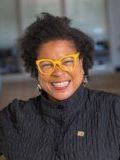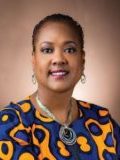
Stephanie Smith,
Chief Inclusion and Diversity Officer,
Fifth Third Bank
Creating a culture of diversity, equity and inclusion takes intentional effort, and as companies place more importance on DE&I initiatives, many are hiring leaders to spearhead efforts, or in the case of companies like DLL, which has offices across the globe, they are appointing leaders from each region who comprise the company’s diversity ambassador network. Why is it important to appoint DE&I-specific leadership if senior leadership is invested in DE&I?
“The role of the chief diversity officer is to set your DE&I strategy, to be the one to provide structure and guidance and have that subject matter expertise in really rolling out the strategy and making sure that your strategy is aligned to your corporate strategy,” Djuana Beamon, chief diversity officer at Peoples United Bank, says. “It shouldn’t be something that’s off the side of somebody’s desk. It should be really closely aligned to your business strategy.”
Beamon says a common myth is that chief diversity officers own all of DE&I. “It’s really leadership’s responsibility to own it and the chief diversity officer’s responsibility to provide that guidance and that structure to really help the organization along their DE&I journey.”

“At Fifth Third, diversity, inclusion and equity are essential to living our core values: serving our customers, delivering financial performance and being recognized as a leader in building an engaging workplace, a strong supplier base and vibrant communities,” Stephanie Smith, chief inclusion and diversity officer at Fifth Third Bank, says. “A chief diversity officer unifies these efforts and takes ownership for the organization.”
“[DE&I] has to be embraced at every level of an organization, and in order for it to take root, it has to start at the top,” Jennifer Fanz, country sales manager for U.S. Healthcare at DLL and a lead ambassador of the company’s diversity ambassador network, says.
Fanz speaks from experience. After starting DLL’s Network of Women as a grassroots effort, she soon discovered that the women organizing in the group wanted leadership to embrace the effort as well. To truly take hold, Fanz says any DE&I initiatives must be a “foundational force” in an organization, which is achieved by saying, “We have dedicated people and dedicated teams and dedicated resources focused on advancing this initiative.”

Taking the First Steps
While many companies have already established DE&I leadership, others have not made it that far. What are the first steps these companies can take to get started?
“For anyone beginning an initiative, it’s important to remember that this commitment is multifaceted,” Smith says. “It involves constituents across your business, your business practices, your customer interactions, your community relationships and, most importantly, your employees. It begins with listening to your employees and customers to find out what their needs are. After that, a company must formulate an action plan to address those needs.”
“It’s really important to do an internal assessment,” Beamon says, suggesting that leadership look at employee engagement survey results by demographics and take action on the results. “Don’t just ask people to fill out a survey and then not do anything with it. That’s the worst thing that you can do.”
Beamon says leadership must share survey results with employees, outline how they are addressing any challenges identified and follow up with regular progress reports. “You really want to make sure that you’re addressing the situation.”
“As a company, you have to be honest with yourself, and in order to do that, you have to look inside,” Fanz says. “The easiest place to start is to take a look at the data. Look at your numbers, and not just at a macro level, but at every level in an organization. Look at your makeup, be honest with yourself as an organization. Ask ‘Where are we doing OK?’ and ‘Where can we do better?’ And then focus on those areas where you can do better.”
When a need has been identified, Fanz says it’s important to focus on these initiatives in your organization, find the people who want to be involved and have them start brainstorming ideas. “Activity breeds progression, so if you’re active and you’re showing people that you’re engaged, it’s going to gain momentum.”
“While there are no one-size-fits-all answers, at Fifth Third, we recently established an Executive Diversity Leadership Council composed of senior and executive leaders from across the company charged with ensuring equality and inclusion in our communities, with our customers and in our workplace,” Smith says. “While our initial focus was on Black communities, customers and employees, we fully understand this work will have broader implications for all diverse [groups]. Additionally, we created resources, such as our ally tool kit that is available for the public, to help guide empathetic, supportive conversations about inequality and bias.”
Looking Outside
While it’s important to compare notes with industry peers, it’s also essential to look outside of the financial industry to monitor trends that promote inclusion and learn from them.
“The pandemic has brought several common themes to the forefront,” Smith says. “These shared factors will influence leaders and how we continue to promote inclusion. Building emotional intelligence and other soft skills is important for leaders. With more employees working from home, business leaders can hold employees accountable for work while empathizing with individual situations. We know the coronavirus pandemic has disproportionately impacted women, and women of color, who often must choose between work and staying home to care for families. With the significant investment in technology and other remote solutions, these employees now have more options and flexibility.”
“We have seen a social reckoning and social awakening over the past year and a half like we have not seen since the Civil Rights movement of the ‘60s and ‘70s. Organizations must look at their mission and define how they are incorporating social justice into their mission, vision and values.” Beamon says. “What are the organizations that your company is supporting from a philanthropic perspective? What are the things that you’re doing internally to show support for your employees? When we had the murders of George Floyd and Ahmaud Arbery and Brianna Taylor and the many others that have happened after that, when we’ve had Asian hate and Jewish antisemitism, what are you doing internally to support your employees so that they know when they come into the four walls of your organization, that they are heard, that they’re valued and that the organization is supporting them and their communities?”
To provide support for employees, Fanz suggests creating employee resource groups (ERGs). “ERGs give a voice to marginalized groups that want to come together and do better for themselves and for the organization. So that is a really easy way to be able to start facilitating that change.”
“Is your board diverse? And if they’re not, are you sourcing diverse talent for your board?” Beamon says. “I think when you have a diverse board, that challenges you to be more diverse internally also. Because they will ask the tough questions, they will hold you accountable, they will hold your CEO accountable.”
To make leadership accountable, Beamon says many organizations are tying executive compensation to their diversity goals. “Quotas do not work, and I would never recommend or suggest quotas at all,” Beamon says. “But what gets measured, gets done. So, if you’re looking at your organization and it’s not very diverse and that’s your goal to increase representation, then you may need to have goals around that but not quotas.”
Leading by Example
Peoples United Bank, Fifth Third Bank and DLL have launched several DE&I initiatives that could serve as an example to other equipment finance companies. Five years ago, Peoples United launched its Women in Leadership program, which focuses on developing women within the bank and providing community outreach to women and children. Peoples United also focuses its philanthropic efforts on the communities it serves, particularly women and communities of color.
“We are doing wealth training and webinars to help close the wealth gap in different communities, whether it’s women, people of color or low income, just making sure that we’re providing resources and opportunities for people to change their socioeconomic status,” Beamon says.
DLL has an Allies for Inclusion program, a multiple-module program in its learning and development space where there’s on-demand learning as well as community involvement. DLL also offers recruiting training designed to help managers learn how to recruit without bias, as well as a women’s empowerment series. DLL also has a Diversity Inclusion Council comprised of several members of its management team, its network of ambassadors across the globe focused on DE&I and its member resource groups.
“As we work toward creating equitable outcomes for all, we have launched a $2.8 billion commitment that will provide $2.2 billion in lending, $500 million in investments, $60 million in financial accessibility and $40 in philanthropy, including grants from the Fifth Third Foundation, as part of the Executive Diversity Leadership Council’s Accelerating Racial Equality, Equity and Inclusion initiative,” Smith says. “The three-year pledge focuses on three constituents: employees, customers and communities. Each vertical has a specific emphasis on accelerating our progress toward an equitable environment for all.”
Rita E. Garwood is editor in chief of Monitor.
No categories available
No tags available